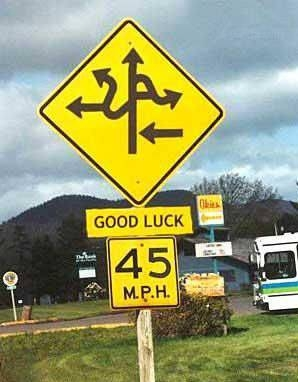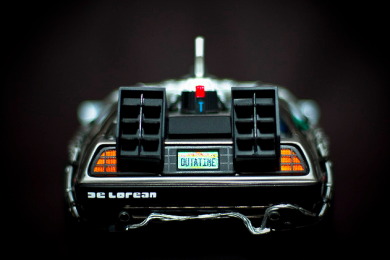Why Too Many Flashbacks Might Be a Warning of Deeper Story Problems

Image vis Flickr Creative Commons, courtesy of Yuya Sekiguchi.
This week we have been discussing flashbacks. What are they? Why do readers, agents, editors generally want to stab them in the face? Is it truly a flashback or is the writer employing an unorthodox plotting structure (The Green Mile or The English Patient)? Shifting time IS a legitimate literary device, but like ALL literary devices, it has strengths and weaknesses.
Theme is wonderful. But if we lay it on too thick, we can turn off readers because our story comes across as preachy or lecturing. Symbolism? Love it! But overdo this and readers can get irritated. Can the drapes JUST BE BLUE? Deus ex machina IS a legitimate literary device. Feel free to use it. I wouldn’t recommend it, but knock yourself out.
As I like to say, Have fun storming the castle! *waves and grins*
Deus ex machina hasn’t been used much since, oh, Odysseus, but hey. It might work. *cough Neverending Story* Anything can work. Don’t let me stop you.
All righty. Today, I’d like to talk about WHY flashbacks can be red flags for me as a teacher/editor. I feel I can speak to this because when I started writing I was CLUELESS. My first novel is being used in GITMO because it is more effective than water boarding.
So, why might too many flashbacks make people like me twitchy?

Our WIP can feel a little like THIS…
We Don’t Have a Core Story Problem
Most new writers cannot tell you what their book is about in ONE sentence, yet that is all we should need. Three, MAX, but one is better. I don’t care how complicated or long the work, it should have a simple core.
Lord of the Rings
A naive, sheltered race must leave home for the first time and toss an evil ring in a volcano before darkness destroys their world and all they love.
Simple. Ah, but simple is not always easy. And while Lord of the Rings is EPIC in length, with mind-bending description and layers and symbols and sub-plots and invented languages…the core is simple. Destroy The Ring of Power before Sauron casts the world in darkness and destroys everyone.
Many new writers don’t know how to plot or believe plotting means writing will be formulaic (which us UNTRUE). Or they have no idea how to whittle all the shiny fabulous ideas in their heads and pick ONE. Thus, flashbacks become a way that we explore different stories and ideas, but since there is no skeleton, we have a gelatinous mess only we love or understand.
Whether a pantser (write by the seat of your pants) or a plotter or a mixture of both (me) we need to know what our story is ABOUT.
This is often why, when I challenge writers to write the ending first?
*BOOM! Brain matter all over the walls*
But, if we KNOW our story problem, the ending should be there (or at least AN ending). In the LOTR, we know if they don’t toss the ring in the volcano, they lose. We know the story ends somewhere near….wait for it….a volcano.
Same in literary fiction. In The Joy Luck Club if June Mei isn’t on that boat to China in the end, she has failed to break the cycles of the past. In The Road if Man and Boy resort to snacking on people to reach the ocean, they fail. There is still a goal and there has to be a goal in order to generate true dramatic tension.
Thus, flashbacks are often a way of us trying to figure out what the story is really about. While this is a good exercise, it is a loooong and arduous way to write books.

Back to the future, then past then future…
We Don’t Yet Know Our Characters
Often flashbacks (particularly for the new pre-published writer) are a way we use to get to know who we are writing about. Maybe we aren’t comfortable with a character background sheet. It feels too… “Fill in the Blank.” I was that way and still am. This is why, when I do a character background, I write their life stories first. Then I can pick what is salient and have a developed character who is three-dimensional.
We Have Chosen the WRONG Protagonist
Writers are weird ducks, but y’all know that *quack quack*. We have to be ruthless almost to the point of sociopathy, but on the flip side, we must be intimate and vulnerable in a way mere mortals can’t be. In the beginning, being vulnerable is hard. It might always be hard. But for those of you who’ve had a work that had a ton of flashbacks, I’d like to ask this.
Did you begin your work thinking the story was about one character, only to find out you were telling the wrong story? That you’d unwittingly cast the wrong person?

Image via Flickr Creative Commons courtesy of Robert Ellsworth Tyler
When we are new, we are insecure. Mainly because our family might be more supportive if we’d chosen to join a cult. Our protagonist is often US or at least a reflection, and, since we feel insecure, we often end up with a perfect protagonist, which is code for “dull as dirt.” Why? We can’t be vulnerable.
Ah, but supporting characters are different. We don’t have the same armor on with those guys…which is often why people love them more and they often stage a story coup and take over.
We Have Chosen the Wrong Beginning
Sometimes flashbacks occur because our subconscious senses we aren’t starting in the correct place. We have gone too far into the action and our subconscious is dragging us back.
The flip side of this is everything is cause and effect. We sometimes just have to pick a point and start THERE. My first book in the trilogy I’m working on is a good example (and an easy one for the moment).
Romi is broke and without a job because her ex-fiance pulled an ENRON, stole a half a billion dollars, cleaned out all her accounts, and left her the FBI’s prime suspect…even though she IS an innocent victim.
I had to make a choice. Begin the book when she is down and out and blackballed OR start the story when she gets out of college and lands a dream job and dream fiancé (who will both turn into nightmares). Either would have worked. I picked starting after the $#%^ hit the fan.
Just because a set of events made a character a certain way doesn’t mean this information is salient to the plot problem. We all have a background and are all a collection of our experiences. And we could look for causation ad infinitum and go back thousands of years to figure out why. But that makes a LONG book and is therapy not fiction.

Image via Frank Selmo WANA Commons
Emotional Distancing
As I’ve shown in examples over this week, flashbacks can be a symptom that we are doing something right. We ramped up the tension to the point of shredding nerves (GOOD), but then, to ease our own anxiety, we flashed back to explain. Remember great fiction is totally counterintuitive to what normal humans do. Fiction is the path of greatest resistance.
We might be avoiding a storyline or casting a certain character because it hits too close to home.
I did this with my first novel The Past Never Dies (does the title tell you anything?)
In this book I was “attempting” to run two parallel timelines. Vivi was the outgoing world traveler and her friend, Eileen, she left behind was trapped by paralyzing OCD. The friend was living vicariously through gifts and letters and journals (I KNOW. I told y’all I’ve done all this, too).
But what was really fascinating to me was people didn’t care for Vivi (a character I projected as me at the time). She was too perfect and thus a caricature. Eileen, on the other hand, had the far more interesting story.
In the beginning, Eileen is trapped by OCD and a survivor of religious abuse. She grew up with an OLD SCHOOL Pentacostal preacher for a father who hated women, and a mother who’s too browbeaten to fight back. To compound this trauma, she was tormented in school because her father insisted she wear homemade long dresses, no makeup or jewelry and never cut her hair (in the sweltering heat of Florida).
In fact, this is how Vivi and her became friends. Vivi took on the bullies.
I tell that all in many, many….*sigh* many flashbacks.
Eileen has a routine and is borderline Aspergers. Her routine must be as precise as a Swiss watch or she short-circuits. She breaks free of Dad and explores her passion for art. Just as she is opening up, she’s the victim of a cruel and public prank at her workplace.
For the first time, she bolts. Instead of turning inward, she finally blows outward. She burns her paintings and literally walks away from her life in a very Thelma & Louise way. She rebels.
This parallel story (and the one I believed to be lesser of the two stories) arcs from Eileen being repressed, bullied and enslaved to facing those demons and finally experiencing liberation and actualization.
Vivi? A travel brochure and manufactured drama. Every poor family member who read my TOME loved Eileen’s story and was bored to tears by Vivi’s.
Why?
I wanted to be Vivi. I was Eileen. I could be vulnerable with Eileen because, in my mind, I was Vivi not Eileen.
At the time I wrote the book, I was a slave to OCD and had crippling panic attacks and social anxiety. I would shop at three in the morning so I didn’t run into people. I was terrified of the outside world and others…and that is why Eileen was far more authentic and REAL. She was deeply and profoundly flawed yet overcame it.
I have seen this same phenomena time and time and time again with writers I’ve worked with. They will believe wholeheartedly their story is about Such-and-Such, but it is really about a character they “thought” was in the supporting cast.
Summing Up
Can you use flashbacks? Yes. But if we are using too many, ask the hard questions:
1. Do I have a CORE story problem I can articulate in three sentences or less?
2. Do I truly know my characters?
3. Have I chosen the wrong protagonist?
4. Am I starting in the correct spot?
5. Am I failing to choose a certain spot because I fear commitment or failure so I keep digging back in time to avoid moving forward? The past is set, the future not. Ground is given, sky is scary.
6. Am I using the flashback to emotionally distance from a story, an event or even a character?
7. If I am afraid of this thread or this character, is that perhaps the better direction to go?
In the BBT Gold class is we talk, a lot. I am more of a Book Therapist than Doctor. Often writers know the story they yearn to tell. What I do is listen to all the ideas and characters and dramas and say, “I hear all of this, but what I am hearing is your story is really about X.” I don’t have a magic ball, just good listening skills that can peel away a bunch of stuff I’m not attached to (but the writer is).
This class is designed to save a LOT of time, money and fruitless revisions. Everyone walks away with their story on a sentence, a basic plot and a very clear idea of what their novel truly is about.
Six hours or less can save you six years or more :D .
Like couples therapy. You and your WIP. You think it’s about the toothpaste lid being left off alien invasion and her childhood when it isn’t. An outside professional can help you go deeper to what’s at the heart of the matter/story, whether that is me, a good editor, a great critique partner or group.
I hope at the end of these posts you can see why I am not really being mean when I challenge you to lose flashbacks. My goal is for you guys to tell the story you were born to tell, but sometimes we are our own worst enemy.
What are your thoughts?
For those who’ve relied on too many flashbacks, does this help? Maybe you’ve picked the wrong point in time or are scared of your true story? Have you cast the wrong character before? Maybe handed your work to others and they ask, “Why aren’t you writing about HER?” Are you going backward because you fear going forward, or maybe don’t know how to?
I LOVE hearing from you!
To prove it and show my love, for the month of APRIL, everyone who leaves a comment I will put your name in a hat. If you comment and link back to my blog on your blog, you get your name in the hat twice. What do you win? The unvarnished truth from yours truly. I will pick a winner once a month and it will be a critique of the first 20 pages of your novel, or your query letter, or your synopsis (5 pages or less).
If you want more help with plot problems, antagonists, structure, beginnings, then I have a FANTASTIC class coming up to help you!
CLASS COMES WITH HANDOUTS AND FREE RECORDING.
Understanding the Antagonist
If you are struggling with plot or have a book that seems to be in the Never-Ending Hole of Chasing Your Tail or maybe you’d like to learn how to plot a series, I am also teaching my ever-popular Understanding the Antagonist Class on May 10th from NOON to 2:00 P.M. (A SATURDAY). This is a fabulous class for understanding all the different types of antagonists and how to use them to maintain and increase story tension.
Remember, a story is only as strong as its problem ;) . This is a GREAT class for streamlining a story and making it pitch-ready.
Additionally, why pay thousands for an editor or hundreds for a book doctor? This is a VERY affordable way to make sure your entire story is clear and interesting. Also, it will help you learn to plot far faster and cleaner in the future.
Again, use WANA10 for $10 off.
I’ll be running the First Five Pages again at the end of May, so stay tuned.
And, if you need help building a brand, social media platform, please check out my latest best-selling book, Rise of the Machines—Human Authors in a Digital World.






